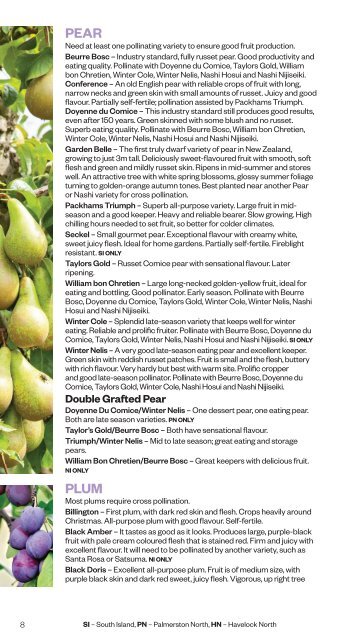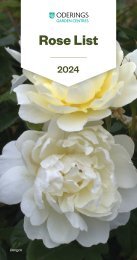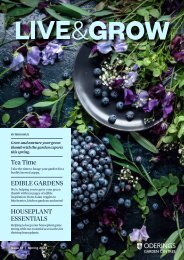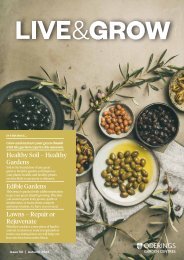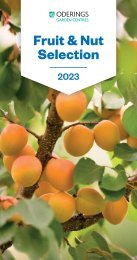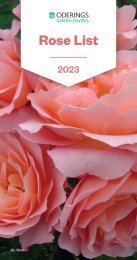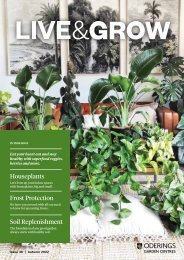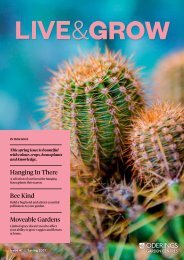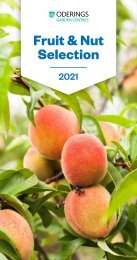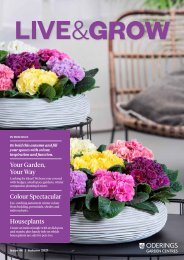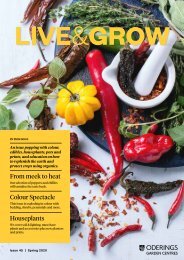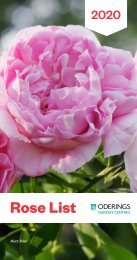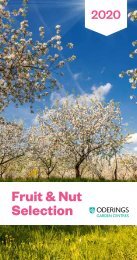Fruit & Nut Selection 2024
Discover our wide array of fruit and nut trees available, including apples, pears, plum trees, and many more options.
Discover our wide array of fruit and nut trees available, including apples, pears, plum trees, and many more options.
You also want an ePaper? Increase the reach of your titles
YUMPU automatically turns print PDFs into web optimized ePapers that Google loves.
PEAR<br />
Need at least one pollinating variety to ensure good fruit production.<br />
Beurre Bosc – Industry standard, fully russet pear. Good productivity and<br />
eating quality. Pollinate with Doyenne du Comice, Taylors Gold, William<br />
bon Chretien, Winter Cole, Winter Nelis, Nashi Hosui and Nashi Nijiseiki.<br />
Conference – An old English pear with reliable crops of fruit with long,<br />
narrow necks and green skin with small amounts of russet. Juicy and good<br />
flavour. Partially self-fertile; pollination assisted by Packhams Triumph.<br />
Doyenne du Comice – This industry standard still produces good results,<br />
even after 150 years. Green skinned with some blush and no russet.<br />
Superb eating quality. Pollinate with Beurre Bosc, William bon Chretien,<br />
Winter Cole, Winter Nelis, Nashi Hosui and Nashi Nijiseiki.<br />
Garden Belle – The first truly dwarf variety of pear in New Zealand,<br />
growing to just 3m tall. Deliciously sweet-flavoured fruit with smooth, soft<br />
flesh and green and mildly russet skin. Ripens in mid-summer and stores<br />
well. An attractive tree with white spring blossoms, glossy summer foliage<br />
turning to golden-orange autumn tones. Best planted near another Pear<br />
or Nashi variety for cross pollination.<br />
Packhams Triumph – Superb all-purpose variety. Large fruit in midseason<br />
and a good keeper. Heavy and reliable bearer. Slow growing. High<br />
chilling hours needed to set fruit, so better for colder climates.<br />
Seckel – Small gourmet pear. Exceptional flavour with creamy white,<br />
sweet juicy flesh. Ideal for home gardens. Partially self-fertile. Fireblight<br />
resistant. SI ONLY<br />
Taylors Gold – Russet Comice pear with sensational flavour. Later<br />
ripening.<br />
William bon Chretien – Large long-necked golden-yellow fruit, ideal for<br />
eating and bottling. Good pollinator. Early season. Pollinate with Beurre<br />
Bosc, Doyenne du Comice, Taylors Gold, Winter Cole, Winter Nelis, Nashi<br />
Hosui and Nashi Nijiseiki.<br />
Winter Cole – Splendid late-season variety that keeps well for winter<br />
eating. Reliable and prolific fruiter. Pollinate with Beurre Bosc, Doyenne du<br />
Comice, Taylors Gold, Winter Nelis, Nashi Hosui and Nashi Nijiseiki. SI ONLY<br />
Winter Nelis – A very good late-season eating pear and excellent keeper.<br />
Green skin with reddish russet patches. <strong>Fruit</strong> is small and the flesh, buttery<br />
with rich flavour. Very hardy but best with warm site. Prolific cropper<br />
and good late-season pollinator. Pollinate with Beurre Bosc, Doyenne du<br />
Comice, Taylors Gold, Winter Cole, Nashi Hosui and Nashi Nijiseiki.<br />
Double Grafted Pear<br />
Doyenne Du Comice/Winter Nelis – One dessert pear, one eating pear.<br />
Both are late season varieties. PN ONLY<br />
Taylor’s Gold/Beurre Bosc – Both have sensational flavour.<br />
Triumph/Winter Nelis – Mid to late season; great eating and storage<br />
pears.<br />
William Bon Chretien/Beurre Bosc – Great keepers with delicious fruit.<br />
NI ONLY<br />
PLUM<br />
Most plums require cross pollination.<br />
Billington – First plum, with dark red skin and flesh. Crops heavily around<br />
Christmas. All-purpose plum with good flavour. Self-fertile.<br />
Black Amber – It tastes as good as it looks. Produces large, purple-black<br />
fruit with pale cream coloured flesh that is stained red. Firm and juicy with<br />
excellent flavour. It will need to be pollinated by another variety, such as<br />
Santa Rosa or Satsuma. NI ONLY<br />
Black Doris – Excellent all-purpose plum. <strong>Fruit</strong> is of medium size, with<br />
purple black skin and dark red sweet, juicy flesh. Vigorous, up right tree<br />
habit. A Cross variety. Mid-season. Self-fertile but better when planted<br />
with Billington, Duff‘s Early Jewel, Elephant Heart or Santa Rosa.<br />
Burbank – Large round dark red fruit and sweet, juicy, aromatic yellow<br />
flesh. Crops regularly and heavily. Mid-season. Hardier selection. Partially<br />
self-fertile, though pollinators are Duff‘s Early Jewel, Omega and Sultan.<br />
Coes Golden Drop – Superb mid- to late-season plum. Large oval yellow<br />
fruit both rich in taste and with juicy flesh. Best planted with Greengage,<br />
Damson, Reine Claude de Bavay or Italian prune plum.<br />
Damson – A highly productive variety of small tart oval fruit with blue<br />
skin and yellow flesh. Best eaten when fully ripe or used for bottling. A<br />
compact grower that is best in colder areas. European variety. Expect<br />
fruit once tree is 3–4 years old. Self-fertile.<br />
Duffs Early Jewel – Pick at Christmas! Medium to large dark red–<br />
skinned fruit with yellow flesh. Considered self-fertile. Good pollinator.<br />
Elephant Heart – Old time favourite. Very large heart-shaped fruit with<br />
dark red extremely sweet and juicy flesh. Superb freestone plum. Mid<br />
to late season. Good pollinator. Pollinate with Omega, Santa Rosa and<br />
Sultan.<br />
English Greengage – Very popular. Succulent and sweet smaller fruit with<br />
delicious flavour. Mid to late season. Self-fertile but ideally planted with<br />
Coe’s Golden Drop, Damson, Reine Claude de Bavay or Italian Prune Plum.<br />
Hawera – Highly recommended NZ home-garden selection with large<br />
very dark red–skinned and -fleshed fruit. Freestone, sweet, juicy and<br />
very firm. Self-fertile. Mid-season. Healthy grower.<br />
Luisa – Mid-season plum with yellow skin and flesh that is almost<br />
freestone. Aromatic, fine flesh, juicy and sweet if well ripened on the<br />
tree. Relatively disease resistant in more humid parts of New Zealand.<br />
Self-fertile.<br />
Omega – Popular, with a host of uses. Medium sized with red speckled<br />
skin and red juicy flesh. Late season. Partially self-fertile, though<br />
pollinators are Billington, Burbank, Duff‘s Early Jewel, Elephant Heart,<br />
Santa Rosa and Sultan.<br />
Purple King – This is a quality dessert plum with attractive large fruit that<br />
have purple skin and yellow flesh. Ripens late January. A good choice<br />
for warmer areas of NZ as this vigorous grower shows good tolerance to<br />
heat and humidity. Pollinate with Duff’s Early Jewel, Sultan or Red Doris.<br />
Reine Claude de Bavay – Self-fertile European greengage, which crops<br />
heavily. Richly flavoured fruit. Culinary plum par excellence. Late season.<br />
SI ONLY<br />
Santa Rosa – The queen of all plums! It is among the most flavourful<br />
plums in the world. Medium to large purple-skinned fruit with yellowtinged<br />
pink, juicy, tangy flesh. Partially self-fertile and excellent pollinator.<br />
Early to mid-season.<br />
Satsuma – Blood-red plum with juicy sweet red flesh. Medium sized,<br />
mid-season. Ideal for eating, bottling, jams, jellies, etc. Partially self-fertile.<br />
Pollinators include Santa Rosa. SI ONLY<br />
Shiro – A great small, very hardy tree with fruit that can be cooked now<br />
or frozen for later. <strong>Fruit</strong> are large, golden, sweet and juicy and produced<br />
early in the season. Best pollinated by Santa Rosa. NI ONLY<br />
Sultan – Japanese early to mid-season, medium to large red-fleshed,<br />
deep-red–skinned plum that is soft and juicy and has good flavour.<br />
It bears heavily on a rather low, spreading tree. It comes into bearing<br />
early and is reliable. Recommended for its small size, very good dessert<br />
qualities and reliability. Partially Self-Fertile, though pollinators are<br />
Burbank, Elephant Heart, Omega and Santa Rosa. SI ONLY<br />
8 SI – South Island, PN – Palmerston North, HN – Havelock North<br />
www.oderings.co.nz<br />
9


